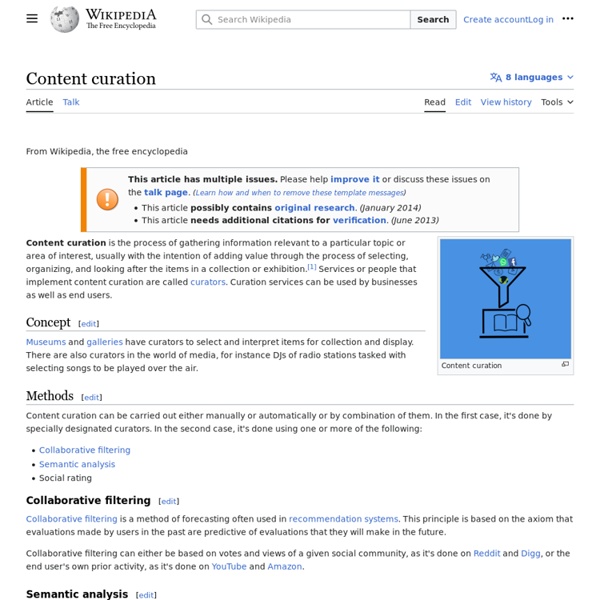Category:Websites
The main article for this category is Website. A website is a set of World Wide Web pages, usually written in HTML, that are viewed using a web browser. This category organizes articles relating to websites. Subcategories This category has the following 40 subcategories, out of 40 total. Pages in category "Websites"
What is content curation? - Definition from WhatIs.com
By Ivy Wigmore, Content Editor Content curation is the gathering, organizing and online presentation of content related to a particular theme or topic. As a rule, a content curation site reproduces some of the original content and links to the full entry. Some content curation sites also provide original content, interpretation and commentary.
Google Bookmarks
Answer three questions and help us improve Wikipedia. Thanks for the feedback! We are using it to make Wikipedia even better!
Content Curation in Workplace Learning
Recent global events have affected how organizations perceive their corporate training initiatives. People are starting to realize how important eLearning tools are in upskilling and reskilling the modern workforce. But with various trends and fads flooding the corporate training landscape today, L&D leaders and HR professionals can’t help but get lost; thus, these “noise” make it hard for them to pick out the essential information. Still, don’t worry! You can cut through the noise by using content curation in your eLearning. Here are the whys and hows:
Alexa Internet
American analytics company providing web traffic data Alexa was founded as an independent company in 1996 and acquired by Amazon in 1999. Its toolbar collects data on Internet browsing behavior and transmits them to the Alexa website, where they are stored and analyzed. This is the basis for the company's web traffic reporting, including its Alexa Rank.[4] According to its website, Alexa provides web traffic data, global rankings, and other information on 30 million websites.[5] As of 2018, its website is visited by over 3 million people every month.[3]
Content Curation & Fair Use: 5 Rules to being an Ethical Content Curator
* Update: I have a much lengthier updated post that incorporates the material below: Content Curation: Copyright, Ethics, & Fair Use Recently, Kimberley Isbell of the Nieman Journalism Lab cited a Harvard Law report and published an extensive post on news aggregation and legal considerations. From a curation perspective, the whole article is interesting, but what was the most surprising was that her recommendations for being an ethical content aggregator, were the same as being an effective content curator. The five recommendations are below. You can read the full article for the legal justifications for abiding by these practices. However, I have provided some reason on why you would want to follow these guidelines from a content marketing perspective:
Digg
Social media/news aggregator website Digg is an American news aggregator with a curated front page, aiming to select stories specifically for the Internet audience such as science, trending political issues, and viral Internet issues. It was launched in its current form on July 31, 2012, with support for sharing content to other social platforms such as Twitter and Facebook.
Lazy Bugger’s Guide to Content Curation
Everybody’s talking about Content Curation – which is cool for us considering it’s basically our name said backwards – but how many people are actually doing it? The answer is not that many, really. Or maybe we should say not that many, yet. Maybe everyone’s put off by how complicated it all sounds…which is where we come in.
List of photo-sharing websites
From Wikipedia, the free encyclopedia This is a non-exhaustive list of major image-sharing websites. Active image-sharing websites Defunct photo-sharing websites
Content curation: A guide to content curation for learning and development (L&D)
Why is content curation important to the future of learning? What are the different approaches to content curation and what are the best platforms and tools for you to achieve effective curation? Where can you go wrong with content curation and why is the curation for learning different from other types of curation?
500px
500px, pronounced five hundred pixels,[2] is a Canadian online photography community[3][4] and marketplace[5] that was co-founded by Oleg Gutsol and Evgeny Tchebotarev (artistically also known as “Ian Sobolev”).[6] The Toronto based startup[7] launched its Web 2.0 version in 2009[8] and is aimed at aspiring and professional photographers;[9] encouraging members to upload their best work.[10] In August of 2015, the company launched a new version of its iOS app.[11] 500px is seen as a place to gain exposure, find inspiration and connect photographers with one another.[12] As of August 2015[update], the site had 6 million users.[13] History[edit] 500px headquarters in Toronto



